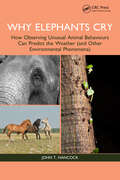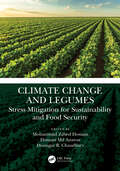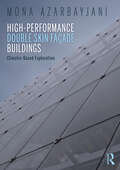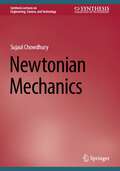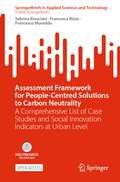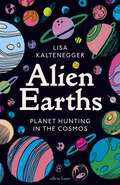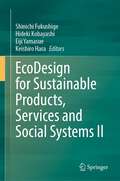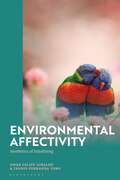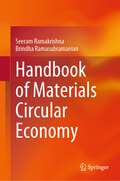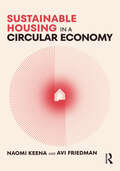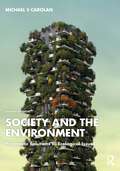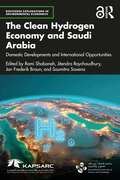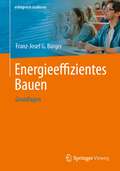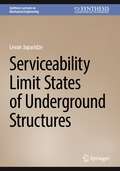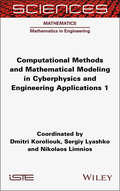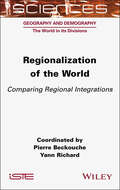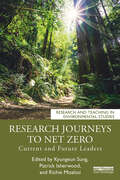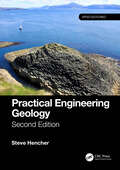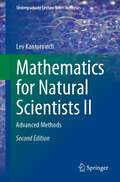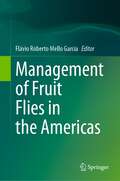- Table View
- List View
Why Elephants Cry: How Observing Unusual Animal Behaviours Can Predict the Weather (and Other Environmental Phenomena)
by John T. HancockWhy Elephants Cry is a fascinating frolic through the literature and evidence surrounding the use of unusual behavior of animals to measure and predict the environment. The role of animals, from the smallest ant to the biggest elephant, as predictors of environmental changes is framed around the climate crisis, which highlights the increasingly important part that animals will have to play in the future. Renowned biologist Professor John T. Hancock collects anecdotal stories and myths along with scientific evidence, demonstrating that observation of animals can be of tangible use. He looks at the measurement of the air temperature using ants, crickets and snakes, and goes on to assess the evidence that the observation of a wide range of animals can predict the weather or the imminent eruption of volcanoes and earthquakes. Evidence of animals being able to predict lunar and solar events, such as lunar cycles and the Northern Lights, is also considered. This is the only time that all this literature has been brought together in one place, a fascinating reference for anybody interested in animals and the environment. The book is also an ideal supplementary textbook for students studying animal behaviour.
Climate Change and Legumes: Stress Mitigation for Sustainability and Food Security
by Mohammad Zabed Hossain Hossain Anawar Doongar R. ChaudharyGlobal climate change has created unprecedented challenges for human civilization due to its widespread adverse consequences, including a reduction in crop yield and threatening food security across the globe. Among the crop plants, legumes have great potential for ameliorating global warming since they can reduce carbon emissions by lowering reliance on the application of chemical fertilizers, by increasing nitrification and carbon sequestration in soil, and by providing protein-rich diets to both humans and livestock. This book identifies the extent of climate-induced stresses on legume plants and focuses on achieving food security through sustainable agricultural practices.This book compiles recent research findings and reviews on climate-related problems, the potential of legumes in ameliorating the impacts of climate change, as well as better management of agricultural land and practices for achieving environmental sustainability and food security.This book will serve as guidelines for scientists, agricultural practitioners, and policymakers working to achieve food security and better management of climate-induced stresses in agricultural interventions. It will also be useful as a reference book for researchers and students of both graduate and postgraduate levels. Furthermore, this book will provide enhanced knowledge about the mechanisms of yield and stress tolerance of legumes as well as developing climate-smart crops and improving cropping systems for a sustainable environment and food security. Features of the book Reviews trends of global climate change and its consequences for food security across the continents Identifies the challenges and scopes of cultivating legumes in achieving food security in the context of global climate change Focuses on the improvements of legume production through conservation approaches in agricultural practices and modern techniques, including omics-based breeding, biotechnology, genetic engineering, and rhizobium technology Discusses the sustainable amelioration options for soils affected by climate-induced stresses Cites examples of applications of rhizobium technologies in reducing greenhouse gas emission Describes pathways associated with yield, resistance, and tolerance of legumes to climate-induced stresses
High-Performance Double Skin Façade Buildings: Climatic-Based Exploration
by Mona AzarbayjaniThis book provides a comprehensive theoretical platform for the use and construction of double skin façade projects. The DSF concept has been used mostly in European buildings; however, its success in other climates should be addressed. Increasing numbers of buildings are featuring double skin façade technology in the US; however, still relatively few have been studied for their performance in operation.This book gives architects a practical guide to analyze and evaluate the actual performance of double skin façade buildings in different climatic contexts. It is important for high-performance buildings to have tools to evaluate a design’s predicted performance to achieve specific sustainable goals. To determine that the application of DSF in different climates will provide better thermal comfort, building simulation tools analyze various thermal comfort parameters through studies of the façade and compare them with the actual building’s performance data. The book takes the reader on an on-site tour of eight DSF buildings around the US. Interviews with the buildings’ architects and engineers, owners, and users offer additional perspectives and insights into the construction and performance of these developments in building design.This will provide architects with a comprehensive understanding of the challenges and opportunities in integrating double skin façades into their projects.
Newtonian Mechanics (Synthesis Lectures on Engineering, Science, and Technology)
by Sujaul ChowdhuryThis book discusses topics related to Newtonian mechanics and is ideal for a one semester course. Introductory topics are first presented including: time, space, and matter; different coordinate systems; vectors; and unit vectors;. The author presents tools such as displacement, velocity, and acceleration to describe projectile motion and uniform circular motion. Newton’s laws of motion and concepts of force and mass are discussed followed by kinetic energy, potential energy, and both conservative and non-conservative forces. This class-tested book also introduces angular displacement, angular speed, and angular acceleration as well as the use of these to describe the motion of particles with constant angular acceleration. Concepts of torque, angular momentum, and rotational inertia are presented to explain the motion of physical pendulum. Motion under central force is also covered and Kepler’s laws are derived.
Assessment Framework for People-Centred Solutions to Carbon Neutrality: A Comprehensive List of Case Studies and Social Innovation Indicators at Urban Level (SpringerBriefs in Applied Sciences and Technology)
by Sabrina Bresciani Francesca Rizzo Francesco MuredduThis open access book presents a catalogue of over one thousand indicators which can be used by cities' public administrators to monitor and evaluate social innovation action plans to support people-centred, collaborative or co-designed solutions to lower carbon emissions. Indicators are clustered according to a framework of social innovation solutions for climate neutrality at city level, developed by merging top-down academic knowledge with bottom-up pragmatic case studies. There is currently limited guidance on how to embed social innovations in their cities’ action plans with the aim of reaching climate neutrality, and on how to assess the progress and impacts of such people-centred projects in cities. The book addresses this gap and is thus relevant for scholars in the field of policy-making and design, as well as cities’ transition teams, policymakers and consultants. Based on the work developed within the EU-funded project NetZeroCities, intervention logics are provided for each of the ten categories of action, with related indicators clustered by category and evaluation criteria (effectiveness, efficiency, relevance, replicability, and scalability). Guidelines to implement the framework support city administrators in defining steps they need to follow to apply the indicators to their local case, making social innovation a crucial lever for accelerating systemic transformation.
Alien Earths: Planet Hunting in the Cosmos
by Lisa Kaltenegger‘Lisa Kaltenegger offers first-hand access to her expertise on the search for planets in the universe, and the life they may contain. Along the way, Lisa's breezy narrative style invites you to experience with her the challenges and joys of being a scientist on the frontier of discovery’ Neil deGrasse Tyson, AstrophysicistFor thousands of years, humans have wondered whether we're alone in the cosmos. Now, for the first time, we have the technology to investigate. The question should have an obvious answer: yes or no. But once you try to find life elsewhere, you realize it is not so simple. How do you find it over cosmic distances? What actually is life?Astronomer Lisa Kaltenegger works from Carl Sagan’s former office at Cornell University, where she built a team of tenacious scientists from many disciplines to find life on faraway worlds, using Earth’s diverse biosphere and its history as a Rosetta Stone. With infectious enthusiasm, she provides an eye-opening insider’s guide to the most unusual exoplanets that have shaken our worldview – planets covered in oceans of lava, lonely wanderers lost in space, and others with more than one sun in their sky – as well as the best contenders for Alien Earths. She also shows how close imagined scifi worlds come to reality.We live in an incredible new epoch of exploration. As our witty and knowledgeable tour guide, Professor Kaltenegger shows how we discover not merely new continents, like the explorers of old, but whole new worlds circling other stars – and how we could spot life there. Worlds from where aliens may even be gazing back at us. What if we're not alone?
EcoDesign for Sustainable Products, Services and Social Systems II
by Shinichi Fukushige Hideki Kobayashi Eiji Yamasue Keishiro HaraThis 2-volume book highlights cutting-edge ecodesign research and covers broad areas ranging from individual product and service design to social system design. It includes business and policy design, circular production, life cycle design and management, digitalization for sustainable manufacturing, user behavior and health, ecodesign of social infrastructure, sustainability education, sustainability indicators, and energy system design. Featuring selected papers presented at EcoDesign 2021: 12th International Symposium on Environmentally Conscious Design and Inverse Manufacturing, it also includes diverse, interdisciplinary approaches to foster ecodesign research and activities. In the context of Sustainable Development Goals (SDGs), in particular SDG 12 (Responsible Consumption and Production), it addresses design innovations for sustainable value creation, considering technological developments, legislation, and consumer lifestyles. Further, the book discusses the conceptof circular economy, which aims to develop circular business models for resource efficient society by taking advantage of digital technologies including artificial intelligence, internet of things, digital twin, data analysis and simulation. Written by experts from academia and industry, Volume 2 focuses on the sustainability assessment of product lifecycle, waste management, material circularity and energy efficiency, food and agriculture, user behavior and health, and transportation. The methods, tools, and practices described are useful for readers to facilitate value creation for sustainability.
Environmental Affectivity: Aesthetics of Inhabiting
by Dr Omar Felipe Giraldo Ms Ingrid Fernanda ToroFollowing Spinoza's lead and Latin American environmental thought, this book imagines an embodied environmental ethics based on the relations between sentient beings and sustained by affections, sensibility, the senses, and contact. Engaging embodied, cognitive, phenomenological, aesthetic and psychoanalytic aspects of affectivity, Omar Felipe Giraldo and Ingrid Fernanda Toro help us understand how places inhabit us, and therefore, how places transformed lovingly have the immense capacity to modify the body, to redirect desire, to clarify our sensibility – creating an affectivity in direction opposition to the regime imposed by this global ecocidal capitalism.For the authors, the environmental crisis is more than a technological or economic problem. They see it as a threat to survival inscribed in the deepest foundations of our body, in the intimacy of our skin, in the intensity and tone of our affections, in our desires, in our perceptions and in our sensory-motor capacities. Hence, the immense need to dismantle this system of power embedded in the intimacy of our body and to cultivate a perceptual transformation guided by an empathic knowledge that leads to a different understanding of our belonging in that which exceeds us. This book is a vital manifesto on the political role of affects, an invitation to awaken the sensitive perception anesthetized by the ecologies of cruelty, and an urgent call to understand differently our place in the cosmos in the midst of this war that our civilization has declared on life.
Handbook of Materials Circular Economy
by Seeram Ramakrishna Brindha RamasubramanianThis book provides comprehensive and practical information on the design and implementation of circular systems for various industries, with a focus on Environmental, Social, and Governance (ESG) factors. The scope of the handbook is to cover the materials circularity in a deeper analysis in accordance to ESG used in various industries such as oil and gas, IT, electronics, medicine, textile, and more. The handbook also covers the key principles of the circular economy, including material efficiency, resource conservation, and waste reduction, and how they impact to different industries. It further critically analyses the challenges and opportunities associated with implementing circular systems in these industries, including the framework for new business models and technical innovations, and the potential benefits in terms of environmental protection, social responsibility, and economic competitiveness. In addition to providing practical information, the handbookalso addresses the ESG factors associated with the circular economy exclusively for each industry. This would include the impact of circular systems on the environment, including the reduction of greenhouse gas emissions and the protection of biodiversity, as well as the social benefits, such as job creation, and the economic benefits, such as cost savings and increased competitiveness. The ultimate goal of the handbook should be to provide guidance and support in a niche evaluation for the development of a more sustainable and equitable future, where the circular economy is a key enabler.
Environmental Affectivity: Aesthetics of Inhabiting
by Dr Omar Felipe Giraldo Ms Ingrid Fernanda ToroFollowing Spinoza's lead and Latin American environmental thought, this book imagines an embodied environmental ethics based on the relations between sentient beings and sustained by affections, sensibility, the senses, and contact. Engaging embodied, cognitive, phenomenological, aesthetic and psychoanalytic aspects of affectivity, Omar Felipe Giraldo and Ingrid Fernanda Toro help us understand how places inhabit us, and therefore, how places transformed lovingly have the immense capacity to modify the body, to redirect desire, to clarify our sensibility – creating an affectivity in direction opposition to the regime imposed by this global ecocidal capitalism.For the authors, the environmental crisis is more than a technological or economic problem. They see it as a threat to survival inscribed in the deepest foundations of our body, in the intimacy of our skin, in the intensity and tone of our affections, in our desires, in our perceptions and in our sensory-motor capacities. Hence, the immense need to dismantle this system of power embedded in the intimacy of our body and to cultivate a perceptual transformation guided by an empathic knowledge that leads to a different understanding of our belonging in that which exceeds us. This book is a vital manifesto on the political role of affects, an invitation to awaken the sensitive perception anesthetized by the ecologies of cruelty, and an urgent call to understand differently our place in the cosmos in the midst of this war that our civilization has declared on life.
Sustainable Housing in a Circular Economy
by Naomi Keena Avi FriedmanThis book relates circular economy principles to housing design and construction and highlights how those principles can result in both monetary savings, positive environmental impact, and socio-ecological change.Chapters focus on three key circular economy principles and apply them to architectural construction and design, namely rethinking of the end-of-use phase of a building and the potential of design-for-disassembly; the role of digitization and data standardization in fostering evidence-based circular economy design decision-making; and presenting space as a resource to conserve, via exploration of the sharing economy and flexibility principles. Beyond waste management and material cycles, this book provides a holistic understanding of the opportunities across the building life cycle that can allow for sustainable and affordable circular housing. With case studies from 13 different countries, including but not limited to the Hammarby Sjöstad district in Sweden, the Circle House in Denmark, Benny Farm in Canada, VMD Prefabricated House in Mexico, and the Deep Performance Dwelling in China, authors pair theoretical frameworks with real-world examples.This will be a useful resource for upper-level students and academics of architecture, construction, and planning, especially those studying and researching housing design, building technology, green project management, and environmental design.
Sustainable Housing in a Circular Economy
by Naomi Keena Avi FriedmanThis book relates circular economy principles to housing design and construction and highlights how those principles can result in both monetary savings, positive environmental impact, and socio-ecological change.Chapters focus on three key circular economy principles and apply them to architectural construction and design, namely rethinking of the end-of-use phase of a building and the potential of design-for-disassembly; the role of digitization and data standardization in fostering evidence-based circular economy design decision-making; and presenting space as a resource to conserve, via exploration of the sharing economy and flexibility principles. Beyond waste management and material cycles, this book provides a holistic understanding of the opportunities across the building life cycle that can allow for sustainable and affordable circular housing. With case studies from 13 different countries, including but not limited to the Hammarby Sjöstad district in Sweden, the Circle House in Denmark, Benny Farm in Canada, VMD Prefabricated House in Mexico, and the Deep Performance Dwelling in China, authors pair theoretical frameworks with real-world examples.This will be a useful resource for upper-level students and academics of architecture, construction, and planning, especially those studying and researching housing design, building technology, green project management, and environmental design.
Society and the Environment: Pragmatic Solutions to Ecological Issues
by Michael S CarolanThe fourth edition of Society and the Environment centers its discussion on realistic solutions to the problems that persist and examines current controversies within a socio‑organizational context, shifting focus away from simply explaining what is wrong with the world around us. Introducing this “pragmatic environmentalism,” Carolan discusses the complex pressures and variables that exist where ecology and society collide, with population growth, the increase in demands for food and energy, and transportation and its outsized influence on urban and community patterns. With further attention given to the social phenomena and structural dynamics driving today’s environmental problems, the book concludes with an important reflection on truly sustainable solutions and what constitutes meaningful social change.Each chapter in this interdisciplinary text follows a three‑part structure beginning with an overview of what is wrong and why. This leads into a discussion on each issue’s wide‑ranging implications and, finally, a balanced consideration of realistic solutions. Featuring updated and expanded examples, discussion points, and coverage of recent developments, including the US withdrawing from the Paris Agreement, “booming” national economies and wealth distribution, growing global interest in environmental justice—with particular focus on the links between injustice and race and inequality—climate change, and renewable energy, this new edition remains an essential companion for courses on environmental sociology and sustainability.
Society and the Environment: Pragmatic Solutions to Ecological Issues
by Michael S CarolanThe fourth edition of Society and the Environment centers its discussion on realistic solutions to the problems that persist and examines current controversies within a socio‑organizational context, shifting focus away from simply explaining what is wrong with the world around us. Introducing this “pragmatic environmentalism,” Carolan discusses the complex pressures and variables that exist where ecology and society collide, with population growth, the increase in demands for food and energy, and transportation and its outsized influence on urban and community patterns. With further attention given to the social phenomena and structural dynamics driving today’s environmental problems, the book concludes with an important reflection on truly sustainable solutions and what constitutes meaningful social change.Each chapter in this interdisciplinary text follows a three‑part structure beginning with an overview of what is wrong and why. This leads into a discussion on each issue’s wide‑ranging implications and, finally, a balanced consideration of realistic solutions. Featuring updated and expanded examples, discussion points, and coverage of recent developments, including the US withdrawing from the Paris Agreement, “booming” national economies and wealth distribution, growing global interest in environmental justice—with particular focus on the links between injustice and race and inequality—climate change, and renewable energy, this new edition remains an essential companion for courses on environmental sociology and sustainability.
The Clean Hydrogen Economy and Saudi Arabia: Domestic Developments and International Opportunities (Routledge Explorations in Environmental Economics)
This book provides a first-of-its-kind analysis of the emerging global hydrogen economy from the vantage point of one of the world’s biggest energy providers: Saudi Arabia. In 2021, and within the context of the Circular Carbon Economy framework, Saudi Arabia announced its goal to reach net-zero carbon emissions by 2060 and produce a substantial amount of clean hydrogen annually by 2030. The Kingdom is optimally situated geographically between the major demand markets in Europe and North Asia, from where it can leverage clean hydrogen exports as a potential tool to become a player of strategic importance and successfully diversify its economy under its Vision 2030 program. More broadly, the book charts a course for fossil fuel-exporting countries such as Saudi Arabia to carve a competitive position for themselves over the forthcoming decades using clean hydrogen as a catalyst for the energy transition.With contributions from global energy experts, the chapters in this book provide a multifaceted analysis of the "who," "what," "where," and "why" related to clean hydrogen development within and beyond Saudi Arabia. Collectively, the contributions analyze the countries and regions relevant to Saudi Arabia in terms of dedicated hydrogen policies, projects, and approaches that aim to incentivize production and demand in an increasingly carbon-constrained world. The book is a timely, unique and an indispensable resource for practitioners and students of energy, geopolitics, and climate policy working on hydrogen in academia, applied research, national government bodies, and international organizations.
Energieeffizientes Bauen: Grundlagen (erfolgreich studieren)
by Franz-Josef G. BürgerDer Arbeitsbereich des „Energieeffizienten Bauens“ bietet eine gute Zukunftsperspektive. Die fachliche Auseinandersetzung mit dem Thema „Energieeffizientes Bauen“ erfordert interdisziplinäres Arbeiten. Architekten und Bauingenieure werden bei der Planung und Ausführung der gebäudetechnischen Einrichtungen zunehmend mit den Aufgabenstellungen des Maschinenbaus und der Elektrotechnik konfrontiert. Die Buchinhalte beschreiben die naturwissenschaftlichen Grundlagen für die richtige Wahl der Baumaterialien und Baukonstruktionen im Hinblick auf Energieeffizienz, Nachhaltigkeit und Methoden zur Wirtschaftlichkeitsbetrachtung. Aufgaben am Ende der Kapitel ermöglichen die Selbstkontrolle und Festigung des angeeigneten Wissens.
Serviceability Limit States of Underground Structures (Synthesis Lectures on Mechanical Engineering)
by Levan JaparidzeThe main topic of this book is the calculation of underground structures at the limit states of serviceability. It considers the main schemes typical for underground structures for various purposes, gives the corresponding mathematical models describing the main geo-mechanical and technological factors in the construction and operation of extended excavations. Generalized criteria are proposed for making a technically and economically justified solution of the problem of determining the optimal forms and sizes of workings, bearing capacity, type of support and its erection, depending on the structural features of the rock mass, the primary stress fields of gravitational, tectonic, seismic acting in it. and technological origins, operational requirements for extended excavations. The corresponding algorithms, block diagrams and specific numerical examples of calculations are given. In most of the existing calculation methods the structure is considered in the elastic stage, the strength limit of the bearing capacity is considered as the moment when the maximum internal stresses reach the corresponding design resistances of the material. If it is legitimate to use this criterion in certain cases of calculation of statically determinable structures operating in the given loading mode, then in cases where the support operates in the mode of mutually influencing deformation together with the rock mass, it leads to a significant waste of material.
Computational Methods and Mathematical Modeling in Cyberphysics and Engineering Applications 1
by Dmitri Koroliouk Sergiy Lyashko Nikolaos LimniosMathematical methods in engineering are characterized by a wide range of techniques for approaching various problems. Moreover, completely different analysis techniques can be applied to the same problem, which is justified by the difference in specific applications. Therefore, the study of the analyses and solutions of specific problems leads the researcher to generate their own techniques for the analysis of similar problems continuously arising in the process of technical development. Computational Methods and Mathematical Modeling in Cyberphysics and Engineering Applications contains solutions to specific problems in current areas of computational engineering and cyberphysics.
Regionalization of the World: Comparing Regional Integrations
by Pierre Beckouche Yann RichardOn the world map, macro-regions or global regions have gradually emerged, with varying degrees of success and following different trajectories. The authors of this book attempt to determine whether, within the context of globalization, these macro-regions have become an additional level in the spatial deployment of numerous actors, and whether they have come to stand between the national and global levels. This question has arisen because the increasing scales of trade, environmental problems, migration routes, energy distribution, the construction of major infrastructures etc. transcend national boundaries and are leading states to implement macro-regional cooperation. The authors ask whether these large regional groupings are becoming genuine territories and are the fruit of in-depth regional integration – economic, institutional, legal, normative, political, cultural and in terms of identity. If so, these global regions would therefore become referents that make sense and take root in social representations.
Research Journeys to Net Zero: Current and Future Leaders (Research and Teaching in Environmental Studies)
This book provides useful insight into how academics from diverse disciplinary backgrounds, such as science, engineering, technology, social science, policy, design, architecture, built environment, business, and management, have been conducting research into how to realise net zero emissions to address climate change. This book explores the ways in which countries around the world have pledged to achieve net zero emissions through decarbonisation processes. It presents the highest calibre research and impact activities carried out in the UK, Europe, North America, Australia, Asia, and Africa. Such activities include conceptualisation, opportunity identification, specific case studies, demonstration of proof of concepts, provision of evidence, education of the general public, and knowledge transfer to companies. Further to this, the chapters also bring to light personal career journeys to net zero by current and future international research leaders. From this book, readers will gain a full understanding of net zero research via multiple disciplinary pathways, be inspired by personal accounts, and will learn key methodologies, including quantitative and qualitative approaches. The diversity of authors and topics make the book widely applicable to a range of fields, and it will be of great interest to researchers, students, practitioners, and decision makers working towards the goals of net zero and decarbonisation.
Research Journeys to Net Zero: Current and Future Leaders (Research and Teaching in Environmental Studies)
by Kyungeun Sung Patrick Isherwood Richie MoalosiThis book provides useful insight into how academics from diverse disciplinary backgrounds, such as science, engineering, technology, social science, policy, design, architecture, built environment, business, and management, have been conducting research into how to realise net zero emissions to address climate change. This book explores the ways in which countries around the world have pledged to achieve net zero emissions through decarbonisation processes. It presents the highest calibre research and impact activities carried out in the UK, Europe, North America, Australia, Asia, and Africa. Such activities include conceptualisation, opportunity identification, specific case studies, demonstration of proof of concepts, provision of evidence, education of the general public, and knowledge transfer to companies. Further to this, the chapters also bring to light personal career journeys to net zero by current and future international research leaders. From this book, readers will gain a full understanding of net zero research via multiple disciplinary pathways, be inspired by personal accounts, and will learn key methodologies, including quantitative and qualitative approaches. The diversity of authors and topics make the book widely applicable to a range of fields, and it will be of great interest to researchers, students, practitioners, and decision makers working towards the goals of net zero and decarbonisation.
Practical Engineering Geology (Applied Geotechnics)
by Steve HencherPractical Engineering Geology provides an introduction to the way projects are managed, designed and constructed, and how the engineering geologist can contribute to cost- effective and safe project achievement. The need for a holistic view of geological materials, from soil to rock, and of geological history is emphasised. Chapters address key aspects of• Geology for engineering and ground modelling• Site investigation and testing of geological materials• Geotechnical parameters• Design of slopes, tunnels, foundations, and other engineering structures• Identifying hazards• Avoiding unexpected ground conditionsThis second edition includes a new chapter on environmental issues covering hydrogeology, considerations of climate change, earthquakes, and more. All chapters have been updated, with extensively revised figures throughout and several new case studies of unexpected ground conditions. The book will support practising engineering geologists and geotechnical engineers, as well as MSc level students of engineering geology and other geotechnical subjects.
Practical Engineering Geology (Applied Geotechnics)
by Steve HencherPractical Engineering Geology provides an introduction to the way projects are managed, designed and constructed, and how the engineering geologist can contribute to cost- effective and safe project achievement. The need for a holistic view of geological materials, from soil to rock, and of geological history is emphasised. Chapters address key aspects of• Geology for engineering and ground modelling• Site investigation and testing of geological materials• Geotechnical parameters• Design of slopes, tunnels, foundations, and other engineering structures• Identifying hazards• Avoiding unexpected ground conditionsThis second edition includes a new chapter on environmental issues covering hydrogeology, considerations of climate change, earthquakes, and more. All chapters have been updated, with extensively revised figures throughout and several new case studies of unexpected ground conditions. The book will support practising engineering geologists and geotechnical engineers, as well as MSc level students of engineering geology and other geotechnical subjects.
Mathematics for Natural Scientists II: Advanced Methods (Undergraduate Lecture Notes in Physics)
by Lev KantorovichThis textbook, the second in a series (the first covered fundamentals and basics), seeks to make its material accessible to physics students. Physics/engineering can be greatly enhanced by knowledge of advanced mathematical techniques, but the math-specific jargon and laborious proofs can be off-putting to students not well versed in abstract math. This book uses examples and proofs designed to be clear and convincing from the context of physics, as well as providing a large number of both solved and unsolved problems in each chapter. This is the second edition, and it has been significantly revised and enlarged, with Chapters 1 (on linear algebra) and 2 (on the calculus of complex numbers and functions) having been particularly expanded. The enhanced topics throughout the book include: vector spaces, general (non-Hermitian, including normal and defective) matrices and their right/left eigenvectors/values, Jordan form, pseudoinverse, linearsystems of differential equations, Gaussian elimination, fundamental theorem of algebra, convergence of a Fourie series and Gibbs-Wilbraham phenomenon, careful derivation of the Fourier integral and of the inverse Laplace transform. New material has been added on many physics topics meant to illustrate the maths, such as 3D rotation, properties of the free electron gas, van Hove singularities, and methods for both solving PDEs with a Fourier transform and calculating the width of a domain wall in a ferromagnet, to mention just a few. This textbook should prove invaluable to all of those with an interest in physics/engineering who have previously experienced difficulty processing the math involved.
Management of Fruit Flies in the Americas
by Flávio Roberto Mello GarciaThis book comprises issues at the cutting edge of fruit fly management in the Americas, covering topics that are focal points of current activity and likely long-term importance to the progress of the field. The book is an invaluable source of ideas and inspiration for entomologists at all levels from graduate students to more-established researchers and professionals. Fruit flies (Diptera, Tephritidae) is the most important pests of fruit production worldwide. The purpose of this book is to integrate the experiences of leading scientists in the management of fruit flies in the Americas. In this work, species of fruit flies of economic importance are considered in the genera Anastrepha, Rhagoletis, Bactrocera, and Ceratitis. This book will address fruit flies monitoring, biological control, chemical control, cultural control, sterile insect technique (SIT), Integrated Pest Management (IPM), and other control methods. The book provides invaluable resource material to scientists, professionals and students.
